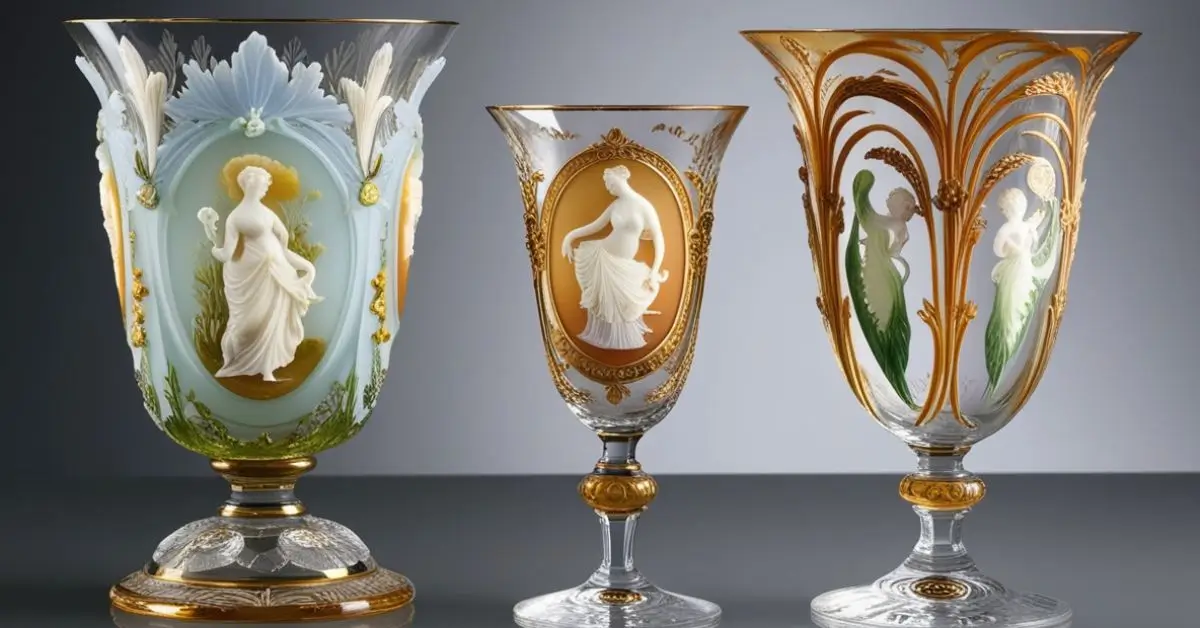Galle Glass: How to Tell if Real. Gallé glass is synonymous with elegance and the innovative artistry of the Art Nouveau era. Crafted by Emile Gallé in the late 19th and early 20th centuries, these exquisite pieces are prized for their intricate designs, use of cameo glass, and nature-inspired motifs. However, as their popularity has soared, so has the number of reproductions and counterfeit pieces. Whether you’re a seasoned collector or an admirer of fine glasswork, distinguishing authentic Gallé glass from imitations is essential. This guide delves into the key elements to identify genuine Gallé glass while offering practical tips for authentication.
What Makes Gallé Glass Special?
Gallé glass is celebrated for its craftsmanship and innovation. Emile Gallé pioneered techniques like acid-etching and cameo glass, layering and carving through colored glass to create intricate designs. His pieces often depict nature’s beauty, including flowers, landscapes, insects, and birds, blending realism with artistic flair.
Each Gallé glass piece carries a story, with subtle details revealing the master’s vision. This uniqueness is one reason they remain highly collectible. However, their value also makes them a target for forgers, emphasizing the importance of authentication.
Key Indicators to Identify Authentic Gallé Glass
1. Signature Details
The signature is one of the most reliable ways to determine if Gallé glass is real. Genuine pieces feature specific traits:
- Accented ‘e’: The name “Gallé” is inscribed with an acute accent over the ‘e’. This detail is often overlooked in reproductions, where the name may appear as “Galle” without the accent.
- Placement: The signature is usually subtle, harmonizing with the piece’s design, rather than prominently displayed. It is often found near the base or integrated into the decorative motif.
- Variations: Gallé used different signatures throughout his career. For example, early pieces may have a simple “Gallé,” while later works might include a star or additional marks.
Signs of a Fake Signature:
- Oversized or prominently displayed signatures.
- Signatures that look out of place or inconsistent with the design.
- Words like “TIP” or additional markings not associated with Gallé’s original works.
2. Glass Quality and Layering
The craftsmanship of genuine Gallé glass is impeccable:
- Multi-Layered Glass: Authentic pieces showcase multiple layers of colored glass, achieved through the cameo glass technique. Each layer contributes to the depth and vibrancy of the design.
- Smooth Transitions: The transitions between colors and patterns are seamless and natural, reflecting meticulous carving and etching.
- Clarity and Finish: Real Gallé glass is free of bubbles, inconsistencies, or uneven edges.
Red Flags:
- Glass that appears single-layered or lacks the depth typical of cameo glass.
- Rough edges or poorly executed designs.
- Artificial-looking colors or uneven patterns.
3. Nature-Inspired Designs
Gallé’s love for nature is evident in his work. His designs are often inspired by flora and fauna, with motifs that appear lifelike yet artistic.
- Themes: Look for flowers like orchids, lilies, or irises, as well as landscapes, insects, and birds.
- Detailing: The carvings and etchings are intricate, with fine details that showcase the artist’s skill.
Imitation Warning:
- Designs that appear overly simplistic or lack the fluidity of natural forms.
- Generic patterns not consistent with Gallé’s style.
4. Base and Weight
The base and overall weight of the glass can offer additional clues:
- Authentic Base: Gallé glass typically has a smooth base that aligns with the piece’s overall craftsmanship. Some pieces may feature pontil marks, indicative of hand-blown glass.
- Weight: Genuine Gallé glass feels substantial and well-balanced, reflecting its high-quality materials.
Counterfeit Clues:
- A rough or uneven base.
- Pieces that feel too light or flimsy, indicating lower-quality glass.
5. Era-Specific Features
Gallé’s work evolved over time, and understanding these changes can aid in authentication:
- Early Period: Simple designs with fewer layers and limited colors.
- Middle Period: More complex cameo glass with vibrant hues and detailed etchings.
- Later Period: Pieces from this time often include the star in the signature, symbolizing Gallé’s advancements in glassmaking.
Tips for Collectors: Research the specific era of a piece and compare its features with known examples from that period.
Comparison Chart: Real vs. Fake Gallé Glass
| Feature | Authentic Gallé Glass | Fake/Reproduction |
|---|---|---|
| Signature | “Gallé” with acute accent, subtle placement | “Galle” without accent, prominent or misplaced |
| Glass Layers | Multi-layered with seamless transitions | Single-layered or poorly executed layers |
| Designs | Nature-inspired, intricate, and lifelike | Simplistic or generic patterns |
| Base | Smooth, sometimes with pontil marks | Rough, uneven, or artificially aged |
| Weight | Substantial and well-balanced | Light or flimsy |
Practical Tips for Verification
- Inspect Under Light: Hold the glass up to natural or bright light to observe its layers and colors. Genuine Gallé glass will exhibit depth and richness that fakes cannot replicate.
- Magnifying Glass Check: Use a magnifying glass to examine fine details. Authentic pieces have sharp and precise carvings, while fakes may show signs of machine-made production.
- Research Provenance: If possible, obtain the piece’s history. Authentic Gallé glass often comes with documentation or a credible source confirming its origin.
- Consult Experts: When in doubt, consult appraisers or experts specializing in antique glass. Their knowledge and tools can help identify subtle signs of authenticity.
- Compare with Known Examples: Reference images and examples of verified Gallé glass can provide a benchmark for comparison.
Common Pitfalls to Avoid
- Relying Solely on Signature: While the signature is a key indicator, it is not foolproof. Some reproductions feature convincing signatures.
- Overlooking Quality: Pay close attention to the glass’s quality and craftsmanship. Even with a correct signature, poor execution is a red flag.
- Buying Without Verification: Avoid purchasing Gallé glass from unverified sources or online platforms without proper documentation.
Resources for Learning More
Enhancing your knowledge about Gallé glass can make you a more confident collector. Consider the following resources:
- Antique Shows and Auctions: Attend events to see and handle authentic pieces.
- Books and Catalogs: Reference works on Art Nouveau glass or Gallé’s creations can provide valuable insights.
- Online Tutorials and Videos: Watching demonstrations of cameo glass techniques can help you appreciate the craftsmanship involved.
Click here for a video on authenticating Gallé glass and cameo techniques. (Add a relevant link to a YouTube video)
The Joy of Owning Authentic Gallé Glass
Owning a piece of Gallé glass is more than acquiring an antique; it’s preserving a slice of art history. Each piece reflects Emile Gallé’s passion for innovation and nature, making it a timeless treasure.
By understanding the hallmarks of authenticity and arming yourself with knowledge, you can confidently navigate the market and find genuine pieces that resonate with your aesthetic and appreciation for craftsmanship.












